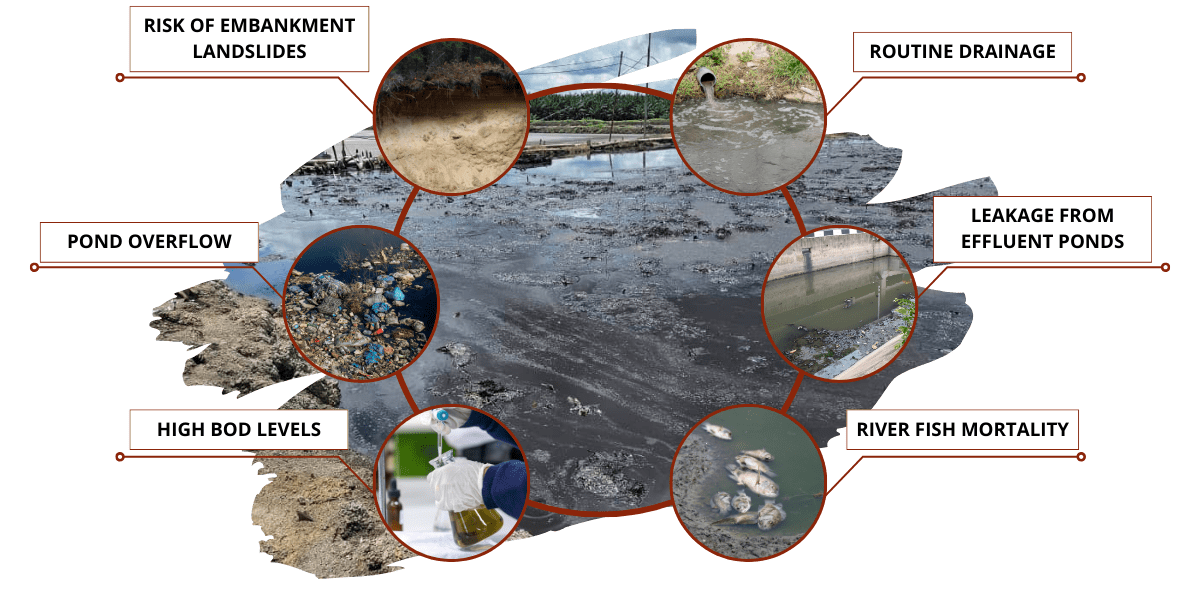Challenges in Handling
Here are some key challenges faced by palm oil mills in managing their effluent:
- Routine Drainage: Palm oil mill effluent needs to be drained regularly to prevent buildup that can disturb the environmental balance. This drainage process requires significant time and resources.
- Risk of Embankment Landslides: Palm oil mills often face the risk of embankment landslides caused by excessive effluent or inadequate construction techniques. This can result in water pollution and damage to natural habitats.
- Leakage from Effluent Ponds: The moisture and acidity of palm oil mill effluent can cause cracks or leaks in storage ponds. This can lead to soil and groundwater contamination in the surrounding areas.
- High BOD Levels: Palm oil mill effluent often has high Biochemical Oxygen Demand (BOD) levels, indicating high organic content. If not properly treated, this can lead to decreased oxygen levels in the water, endangering aquatic life.
- Pond Overflow: When the capacity of effluent storage ponds exceeds its limits, overflow can occur, causing effluent to spread into the surrounding environment and contaminating groundwater and rivers.
- River Fish Mortality: Increased levels of palm oil mill effluent in rivers can lead to mass fish deaths and other species. This not only harms the environment but also disrupts the livelihoods of communities dependent on these natural resources.

In recent years, Malaysia has gained recognition as a significant global player in the production and export of palm oil goods. With each passing year, the proliferation of palm oil mills has accelerated, leading to an increase in the discharge capacity of waste or effluent from fresh fruit bunches. According to data released by the Malaysian Palm Oil Board in 2012, Malaysia's annual production of fresh fruit bunches reached 99.85 million tons. However, the production process necessitates a substantial volume of water, typically ranging from 5 to 5.7 tons per ton of crude palm oil, with approximately half of this water transforming into palm oil mill effluent (POME) during processing.
POME represents a significant environmental challenge in Malaysia, characterized by its high concentration of suspended solids and nutrients, which have the potential to promote the growth of algae. This effluent is identified as a primary environmental concern, particularly within tropical regions like Malaysia.
| Parameter | DOE discharged limit (1986 onwards) | Environmental Quality Act |
|---|---|---|
| BOD (mg/L) | 50 | 100 |
| COD (mg/L) | 1000 | 1000 |
| Total Solids (mg/L) | 1500 | 1500 |
| Suspended Solids (mg/L) | 400 | 400 |
| Oil and Grease (mg/L) | 50 | 50 |
| Ammoniacal Nitrogen (mg/L) | 100 | 150 |
| Total Nitrogen (mg/L) | 200 | 200 |
| pH | 5.0 | 5.0 - 9.0 |
| Temperature (°C) | 45 | 45 |
- Malaysia Department of Environment (DOE)
- Parameters Limit of Environmental Quality (Prescribed Premises) (Crude Palm Oil) (Amendment) Regulation 1997
- No new value stipulated since 1982

Evolution in POME Treatment


- Meru Jaya Advanced Hybrid Electro-Chemical technology is a combination of Electro-Coagulation & Electro-Oxidation process (RT ECO™)
- RT ECO™ is a new generation of technology for POME treatment and creates sustainability in palm oil industry.
- It is an affordable technology to treat POME which have a lot of oil & grease, suspended solid, organic and in-organic contaminants.
